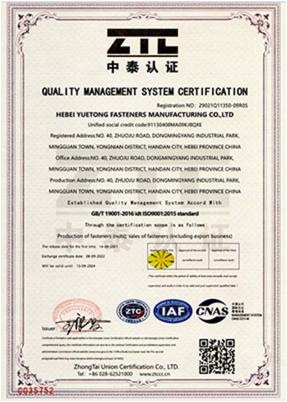Dec . 23, 2024 12:25 Back to list
bending threaded rod
Understanding Bending in Threaded Rods A Comprehensive Overview
Threaded rods are widely used in construction, engineering, and various industrial applications, serving as essential components for joining materials and providing structural support. Their versatility and strength make them a popular choice, but like any mechanical component, they are susceptible to bending under load. Understanding the factors that influence the bending behavior of threaded rods can aid designers and engineers in selecting the right materials and configurations for their projects.
What are Threaded Rods?
Threaded rods are long, slender bars with continuous helical grooves (threads) along their length. They can be made from various materials such as steel, stainless steel, and aluminum, and come in different diameters and lengths to suit various applications. These rods are often used in conjunction with nuts and washers to create secure fastening solutions. Their primary function is to withstand tensile and compressive loads, but their performance is critically influenced by bending moments that can arise from external forces.
Bending Forces and Moments
Bending occurs when an external load is applied to a rod, causing it to deform. The severity of the bend depends on the amount of force applied, the length of the rod, the distance between points of support, and the material properties. The bending moment—a measure of the internal stress produced in an object when subjected to external forces—plays a significant role in determining how the rod will behave under tension or compression.
Factors Influencing Bending of Threaded Rods
1. Material Properties Different materials exhibit differing degrees of stiffness and tensile strength. For example, steel threaded rods are generally more resistant to bending compared to aluminum rods due to higher yield strengths. The modulus of elasticity of the material also affects how much a rod will bend under a given load.
2. Diameter and Length The geometrical properties of the rod are crucial. Thicker rods (with a larger diameter) are typically more resistant to bending, while longer rods are more prone to deflection under load due to the increased leverage effect of the applied force. The ratio of length to diameter (L/d ratio) is a common metric used to predict bending behavior.
bending threaded rod

3. Load Distribution The way loads are applied to threaded rods significantly affects their bending response. A centrally applied load generates a specific bending moment distribution along the rod, while eccentric loads can introduce additional complexities, leading to non-uniform bending and potential failure.
4. End Condition The supports at the ends of the threaded rod also play an integral role in its bending behavior. Fixed supports provide greater resistance to bending compared to simply supported or free ends. Understanding the boundary conditions is essential for accurate modelling and analysis.
Consequences of Bending
When a threaded rod experiences bending, several outcomes can occur. First, excessive bending can lead to permanent deformation, known as yielding. This can compromise the integrity of the joint and potentially lead to failure if the rod cannot withstand the operational loads anymore. Additionally, bending can induce additional stresses in other connected components, resulting in a cascade of failures in the assembly if not properly accounted for.
Design Considerations
Engineers must take bending into account when designing systems that incorporate threaded rods. They should calculate the expected loads and moments acting on the rods in the intended application to ensure that the selected rod can handle these stresses without experiencing excessive deflection or failure. Utilizing finite element analysis (FEA) software can help simulate real-world conditions and assess the performance of threaded rods under various loading scenarios.
In some cases, incorporating additional support or using a combination of rods and other structural components can enhance the overall rigidity of the assembly, preventing undue bending. Additionally, selecting threaded rods with appropriate material properties and geometrical configurations can help mitigate bending issues effectively.
Conclusion
Bending in threaded rods is a crucial factor that engineers and designers must consider in their applications. By understanding the implications of material properties, geometric configurations, load distributions, and boundary conditions, one can effectively predict and manage the bending behavior of threaded rods. This knowledge not only helps in the selection of appropriate components but also ensures the safety and reliability of structural systems. As industries continue to evolve, ongoing research and development in materials science and engineering practices will further enhance the performance of threaded rods and their applications.


